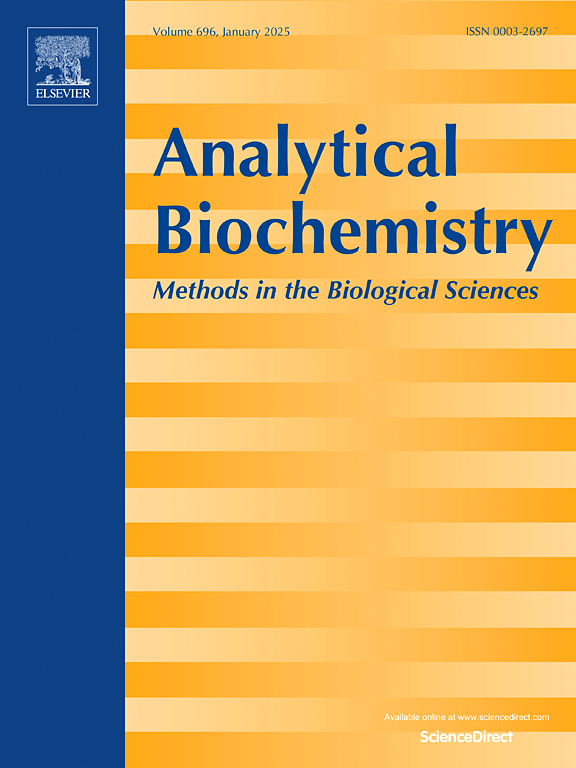MIP-based electrochemical sensor with machine learning for accurate ZIKV detection in protein- and glucose-rich urine
IF 2.5
4区 生物学
Q2 BIOCHEMICAL RESEARCH METHODS
引用次数: 0
Abstract
Nowadays, a multitude of biosensors are being developed worldwide. However, a significant challenge arises when these biosensors are tested in real sample environments, as many of them fail to perform as expected. This can lead to ambiguous results and raise concerns about their reliability. In many cases, further data analysis is required to enhance the clarity and meaningfulness of the outputs. In this study, we investigated the acrylamide-methacrylic acid-methyl methacrylate-vinylpyrrolidone copolymer for fabrication of molecularly imprinted polymers, aimed at developing electrochemical sensors for the direct detection Zika virus in urine. Here, Zika virus detection by the biosensor in three types of urine possibly found in clinical samples including normal, high glucose (glucose >540 mg/dL) and high protein urines (protein >100 mg/dL). The results show that the signal obtained from normal urine increased with virus concentration, while it decreased in urine with high glucose or high protein level. Support vector machine was introduced to unify two opposite trends and resolve ambiguity of the data. It was able to sift through the noise and extract valuable information, thereby improving the reliability and achieved 91 % accuracy in detecting the analyte spiked into real patient samples.

基于mip的电化学传感器与机器学习,用于在富含蛋白质和葡萄糖的尿液中准确检测ZIKV
目前,世界范围内正在开发大量的生物传感器。然而,当这些生物传感器在真实的样品环境中进行测试时,一个重大的挑战就出现了,因为它们中的许多都没有达到预期的效果。这可能导致模棱两可的结果,并引起对其可靠性的担忧。在许多情况下,需要进一步的数据分析,以提高产出的清晰度和意义。在本研究中,我们研究了丙烯酰胺-甲基丙烯酸-甲基丙烯酸甲酯-乙烯基吡咯烷酮共聚物制备分子印迹聚合物,旨在开发用于直接检测尿液中寨卡病毒的电化学传感器。在这里,寨卡病毒通过生物传感器检测在临床样本中可能发现的三种类型的尿液,包括正常、高葡萄糖(葡萄糖>;540 mg/dL)和高蛋白尿液(蛋白质>;100 mg/dL)。结果表明,正常尿液的信号随病毒浓度的增加而增加,而高糖或高蛋白尿液的信号则降低。引入支持向量机统一两种相反的趋势,消除数据的模糊性。它能够过滤噪声并提取有价值的信息,从而提高可靠性,并在检测添加到实际患者样本中的分析物时达到91%的准确率。
本文章由计算机程序翻译,如有差异,请以英文原文为准。
求助全文
约1分钟内获得全文
求助全文
来源期刊

Analytical biochemistry
生物-分析化学
CiteScore
5.70
自引率
0.00%
发文量
283
审稿时长
44 days
期刊介绍:
The journal''s title Analytical Biochemistry: Methods in the Biological Sciences declares its broad scope: methods for the basic biological sciences that include biochemistry, molecular genetics, cell biology, proteomics, immunology, bioinformatics and wherever the frontiers of research take the field.
The emphasis is on methods from the strictly analytical to the more preparative that would include novel approaches to protein purification as well as improvements in cell and organ culture. The actual techniques are equally inclusive ranging from aptamers to zymology.
The journal has been particularly active in:
-Analytical techniques for biological molecules-
Aptamer selection and utilization-
Biosensors-
Chromatography-
Cloning, sequencing and mutagenesis-
Electrochemical methods-
Electrophoresis-
Enzyme characterization methods-
Immunological approaches-
Mass spectrometry of proteins and nucleic acids-
Metabolomics-
Nano level techniques-
Optical spectroscopy in all its forms.
The journal is reluctant to include most drug and strictly clinical studies as there are more suitable publication platforms for these types of papers.
 求助内容:
求助内容: 应助结果提醒方式:
应助结果提醒方式:


